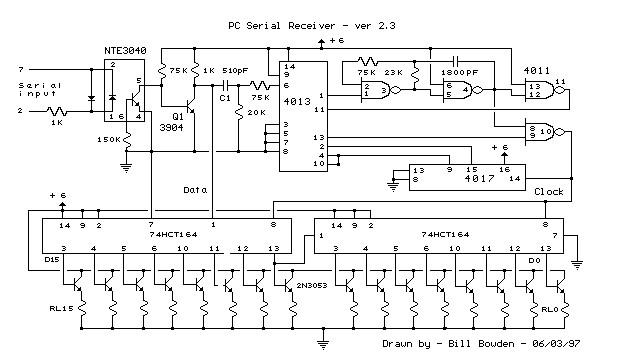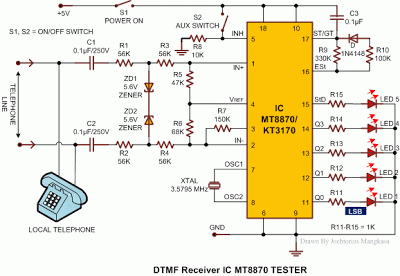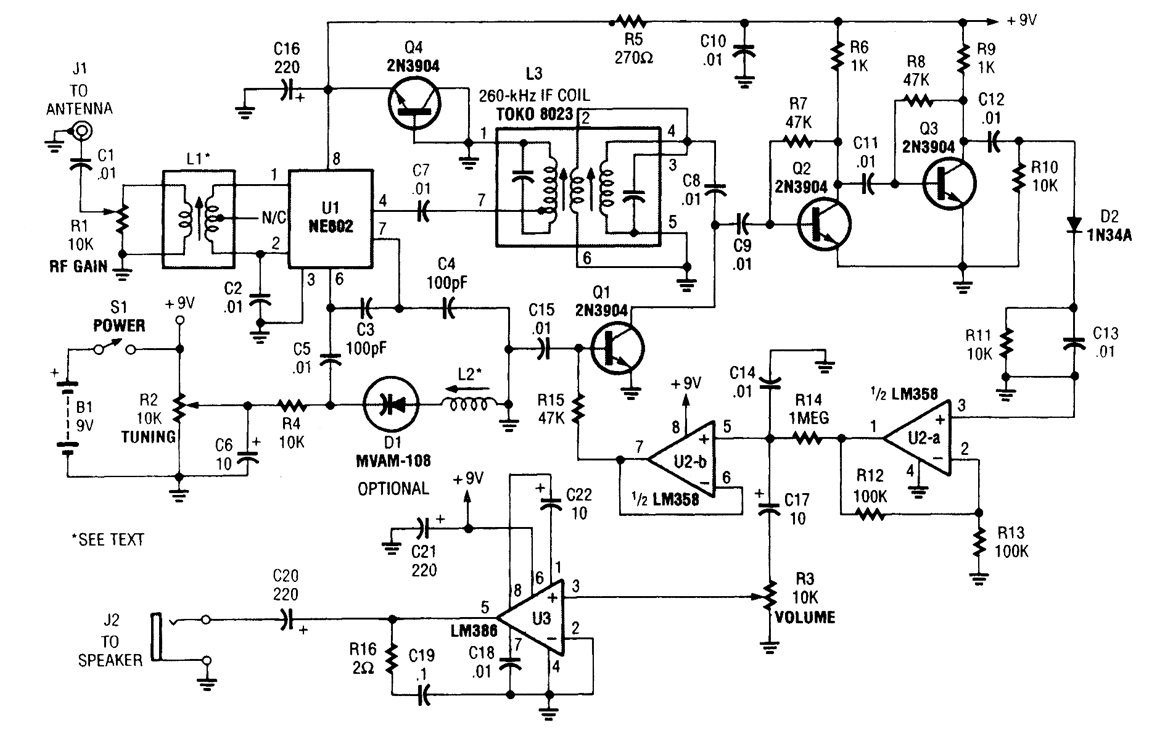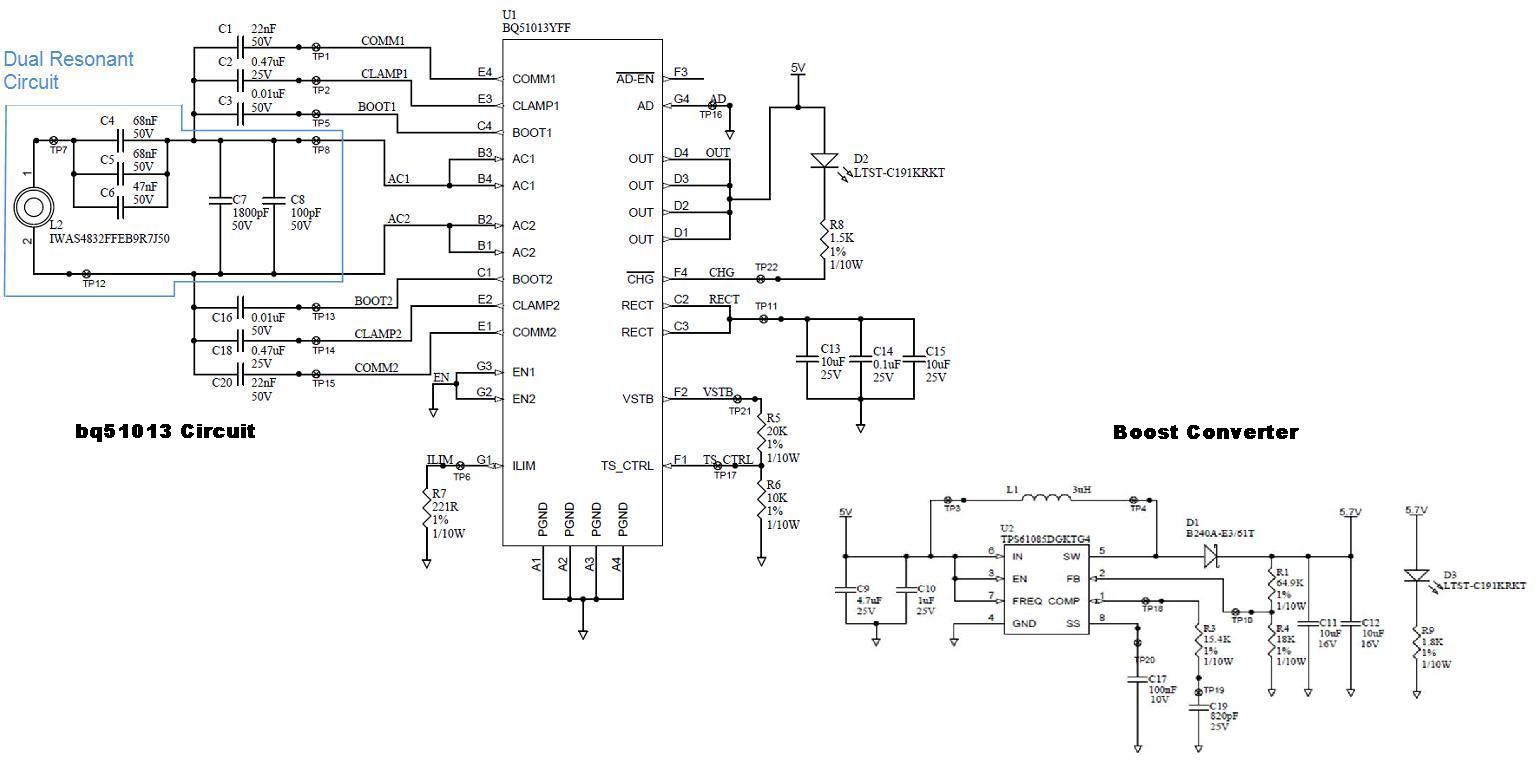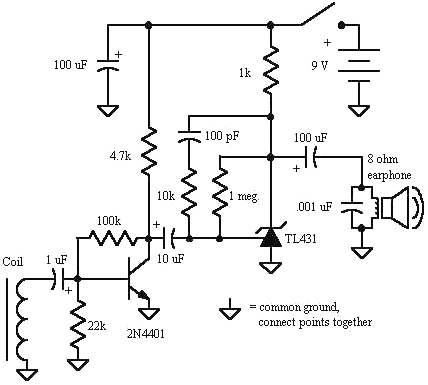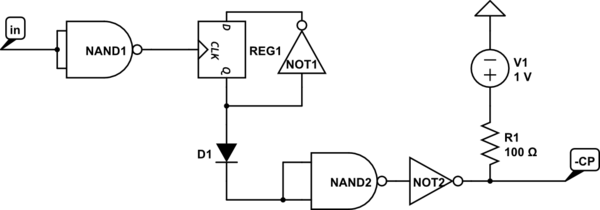
General purpose RF receiver
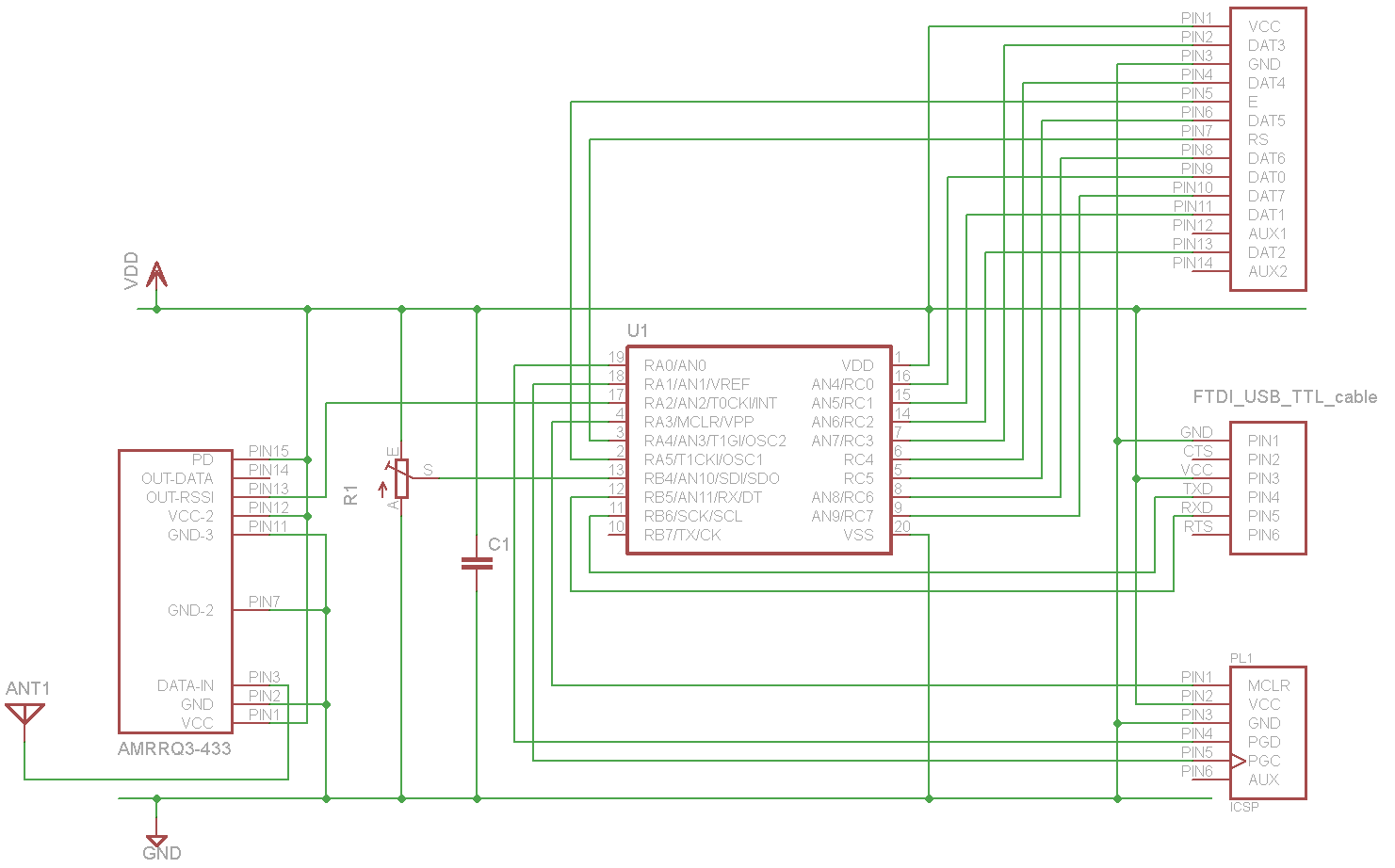
A sensor project that transmits its measurements via a 433 MHz wireless communication link. This document describes the details of a self-built receiver designed to receive data from this sensor. The objective is to create a general-purpose RF receiver module that receives messages from a 433 MHz wireless link (for example, from the self-built RF sensor) and forwards the received and decoded messages to a Linux server via USB, where they undergo further processing. For the USB interface, an FTDI TTL-to-USB cable will be utilized, which is a ready-to-use solution for bridging 5V TTL signals to RS232 emulation over USB. This setup allows the microcontroller to communicate directly with the Linux server without additional components. The Linux kernel supports the FTDI chip, ensuring it functions out of the box. When this cable is connected, the RS232 port is accessible via /dev/ttyUSB0. For debugging purposes and potential future features, the receiver module will be able to write to an HD44780 compatible display (the EAW162B-N3LW) connected via a 14-channel flat cable. A PIC16F690 microcontroller will serve as the main processor, featuring a built-in crystal/clock and sufficient pins to support all interfaces described. To facilitate firmware reprogramming without removing the chip from the board, ICSP (In-Circuit Serial Programming) will be employed. The receiver module is designed to decode messages encoded in a custom RF protocol, which resembles an Ethernet protocol. This protocol includes a destination address field, a source address field, a message length, and a checksum field, but does not specify the content type. The syntax is as follows: when transmitted over RF, the message is encoded using Manchester encoding, which is a self-clocking signal where each bit is represented by two bits. The duration of a low-level bit is 0.5 ms, meaning each logical bit takes 1 ms to transmit. Each message begins with a start bit sent with a HIGH value for 0.5 ms. The most challenging aspect of this project was translating the raw signal provided by the AM-RRQ3-433 into a usable message while filtering out noise and foreign signals. The primary approach is to use the RSSI port of the AM-RRQ3-433 module as the signal source instead of the DATA-OUT port. The RSSI port is an analog output that provides both signal strength information and the actual signal data, while the DATA-OUT port is digital and only conveys the received digital signal via RF. The DATA-OUT port will output a HIGH (5V) for even the slightest noise on the RF channel, whereas the RSSI port outputs a voltage indicative of the received signal's strength. By measuring the RSSI port's output voltage using analog-to-digital conversion (ADC), it is possible to receive the signal and assess its strength. A configurable reference voltage determines the minimum required voltage that the RSSI port must output for the microcontroller to register it as HIGH (1). Any voltage output from the RSSI port below this reference is interpreted as LOW (0) by the microcontroller. After noise filtering, the next step involves translating the received HIGHs and LOWs into a comprehensible message. The attached source code includes a decoder for Manchester encoding based on the finite-state machine concept, which is effective for tracking the current received bit and determining the next expected bit. If a mismatch occurs, if a bit duration exceeds expectations (timeout case), or if the maximum message length is surpassed, the state machine transitions to an error state, halting further reading.
The RF receiver module is designed to operate within a 433 MHz frequency range, suitable for various wireless sensor applications. The integration of the FTDI TTL-to-USB cable simplifies the communication process with the Linux server, allowing for seamless data transfer and processing. The PIC16F690 microcontroller is chosen for its versatility and built-in capabilities, making it ideal for handling the various interfaces required for this project.
The use of the RSSI port for signal reception is a notable feature, as it allows for a more robust detection of valid signals by measuring the strength of incoming RF signals. This capability is essential in environments with potential interference and noise. The configuration of the reference voltage adds an additional layer of flexibility, enabling adjustments based on specific application needs or environmental conditions.
The implementation of the Manchester encoding decoder using a finite-state machine is a sophisticated approach to signal processing, ensuring accurate interpretation of the transmitted data. This method provides resilience against timing variations and signal distortions that may occur during transmission. Overall, this sensor project exemplifies a comprehensive approach to wireless communication, integrating hardware and software components to achieve reliable data transmission and processing.A sensor project which transmits it`s measurements via a 433Mhz wireless communication link. On this page I will describe the details of my self built receiver which receives data from this sensor. To build a general purpose RF receiver module which receives messages from a 433 Mhz wireless link (for example from my self built RF sensor )and forward the received and decoded message to my
Linux server via USB, where they are further processed. For the USB interface, I`ll be FTDI`s TTL-to-USB cable, which is a ready-to-use solution for briding 5V TTL signals to RS232 emulation over USB. This enables the microcontroller talk directly to the linux box without any additional components. The linux kernel supports the FTDI chip, so it works out of the box. When this cable is plugged in, the RS232 port is reachable via /dev/ttyUSB0. For debugging purposes and possible other future features, the receiver module will be able to write to a HD44780 compatible display (I`ll be using the EAW162B-N3LW) which is attached using a 14 channel flat cable For the main processor, a PIC16F690 microcontroller will be used, which has a built-in crystal/clock and enough pins to support all interfaces described above.
For re-programming the firmware of the microcontroller without needing to remove the chip from the board, I`ll be using ICSP (In-Circuit Serial Programming) All messages which this receiver module should be able to receive are encoded in my own RF protocol. This protocol is a kind of Ethernet protocol, it contains a destination address field, a source address field a message length and a checksum field.
This protocol does not say anything about the kind of content which it carries. The syntax looks as follows: When transmitted over RF; the message is encoded using Manchester encoding which is a self-clocking signal where each bit is actually sent using two bits. The length of a low-level bit is 0. 5 ms which means that each logical bit takes 1 ms to transmit. At the beginning of each message, there is a start bit sent with the value of HIGH for 0. 5ms. The hardest part of this project was to translate the raw signal, which the AM-RRQ3-433 provides, to a usable message and disregard any noice and foreign signals.
The main idea here is that the RSSI port of the AM-RRQ3-433 module is used directly as a signal source (instead of the DATA-OUT port). The RSSI port is an analog port which provides both signal strength information and the information in the signal itself, whereas the DATA-OUT port is a digital port and only provides the digital signal received via RF.
The DATA-OUT port will raise to HIGH (=5V) on the slightest noice on the RF channel, while the RSSI port will output a voltage which tells us about how strong the receive signal actually is. So by measuring the output voltage of the RSSI port using AD (analog-digital conversion), it is possible to both receive the signal itself and also the strength of this signal.
So when the microcontroller is receiving a signal from the RF module, a configurable reference voltage provides the minimum required voltage (signal strength) which the RSSI port has to output in order for the microcontroller to recognize this as a HIGH (1). Any voltages which the RSSI port outputs which are below this configurable reference voltage are seen as a LOW (0) by the microcontroller.
The next step after this noice filtering is to translate the received HIGH`s and LOW`s into a understandable message. In the attached source code, I`ve implemented a decoder for manchester encoding which is based on the finite-state-machine concept.
A state machine is ideal to keep track of the current received bit and to determine which is the next expected next bit. As soon as a mismatch is found, a bit lasts too long (timeout case) or the max message length is exceeded, the state machine goes into error state and further reading is
🔗 External reference
The RF receiver module is designed to operate within a 433 MHz frequency range, suitable for various wireless sensor applications. The integration of the FTDI TTL-to-USB cable simplifies the communication process with the Linux server, allowing for seamless data transfer and processing. The PIC16F690 microcontroller is chosen for its versatility and built-in capabilities, making it ideal for handling the various interfaces required for this project.
The use of the RSSI port for signal reception is a notable feature, as it allows for a more robust detection of valid signals by measuring the strength of incoming RF signals. This capability is essential in environments with potential interference and noise. The configuration of the reference voltage adds an additional layer of flexibility, enabling adjustments based on specific application needs or environmental conditions.
The implementation of the Manchester encoding decoder using a finite-state machine is a sophisticated approach to signal processing, ensuring accurate interpretation of the transmitted data. This method provides resilience against timing variations and signal distortions that may occur during transmission. Overall, this sensor project exemplifies a comprehensive approach to wireless communication, integrating hardware and software components to achieve reliable data transmission and processing.A sensor project which transmits it`s measurements via a 433Mhz wireless communication link. On this page I will describe the details of my self built receiver which receives data from this sensor. To build a general purpose RF receiver module which receives messages from a 433 Mhz wireless link (for example from my self built RF sensor )and forward the received and decoded message to my
Linux server via USB, where they are further processed. For the USB interface, I`ll be FTDI`s TTL-to-USB cable, which is a ready-to-use solution for briding 5V TTL signals to RS232 emulation over USB. This enables the microcontroller talk directly to the linux box without any additional components. The linux kernel supports the FTDI chip, so it works out of the box. When this cable is plugged in, the RS232 port is reachable via /dev/ttyUSB0. For debugging purposes and possible other future features, the receiver module will be able to write to a HD44780 compatible display (I`ll be using the EAW162B-N3LW) which is attached using a 14 channel flat cable For the main processor, a PIC16F690 microcontroller will be used, which has a built-in crystal/clock and enough pins to support all interfaces described above.
For re-programming the firmware of the microcontroller without needing to remove the chip from the board, I`ll be using ICSP (In-Circuit Serial Programming) All messages which this receiver module should be able to receive are encoded in my own RF protocol. This protocol is a kind of Ethernet protocol, it contains a destination address field, a source address field a message length and a checksum field.
This protocol does not say anything about the kind of content which it carries. The syntax looks as follows: When transmitted over RF; the message is encoded using Manchester encoding which is a self-clocking signal where each bit is actually sent using two bits. The length of a low-level bit is 0. 5 ms which means that each logical bit takes 1 ms to transmit. At the beginning of each message, there is a start bit sent with the value of HIGH for 0. 5ms. The hardest part of this project was to translate the raw signal, which the AM-RRQ3-433 provides, to a usable message and disregard any noice and foreign signals.
The main idea here is that the RSSI port of the AM-RRQ3-433 module is used directly as a signal source (instead of the DATA-OUT port). The RSSI port is an analog port which provides both signal strength information and the information in the signal itself, whereas the DATA-OUT port is a digital port and only provides the digital signal received via RF.
The DATA-OUT port will raise to HIGH (=5V) on the slightest noice on the RF channel, while the RSSI port will output a voltage which tells us about how strong the receive signal actually is. So by measuring the output voltage of the RSSI port using AD (analog-digital conversion), it is possible to both receive the signal itself and also the strength of this signal.
So when the microcontroller is receiving a signal from the RF module, a configurable reference voltage provides the minimum required voltage (signal strength) which the RSSI port has to output in order for the microcontroller to recognize this as a HIGH (1). Any voltages which the RSSI port outputs which are below this configurable reference voltage are seen as a LOW (0) by the microcontroller.
The next step after this noice filtering is to translate the received HIGH`s and LOW`s into a understandable message. In the attached source code, I`ve implemented a decoder for manchester encoding which is based on the finite-state-machine concept.
A state machine is ideal to keep track of the current received bit and to determine which is the next expected next bit. As soon as a mismatch is found, a bit lasts too long (timeout case) or the max message length is exceeded, the state machine goes into error state and further reading is
🔗 External reference
